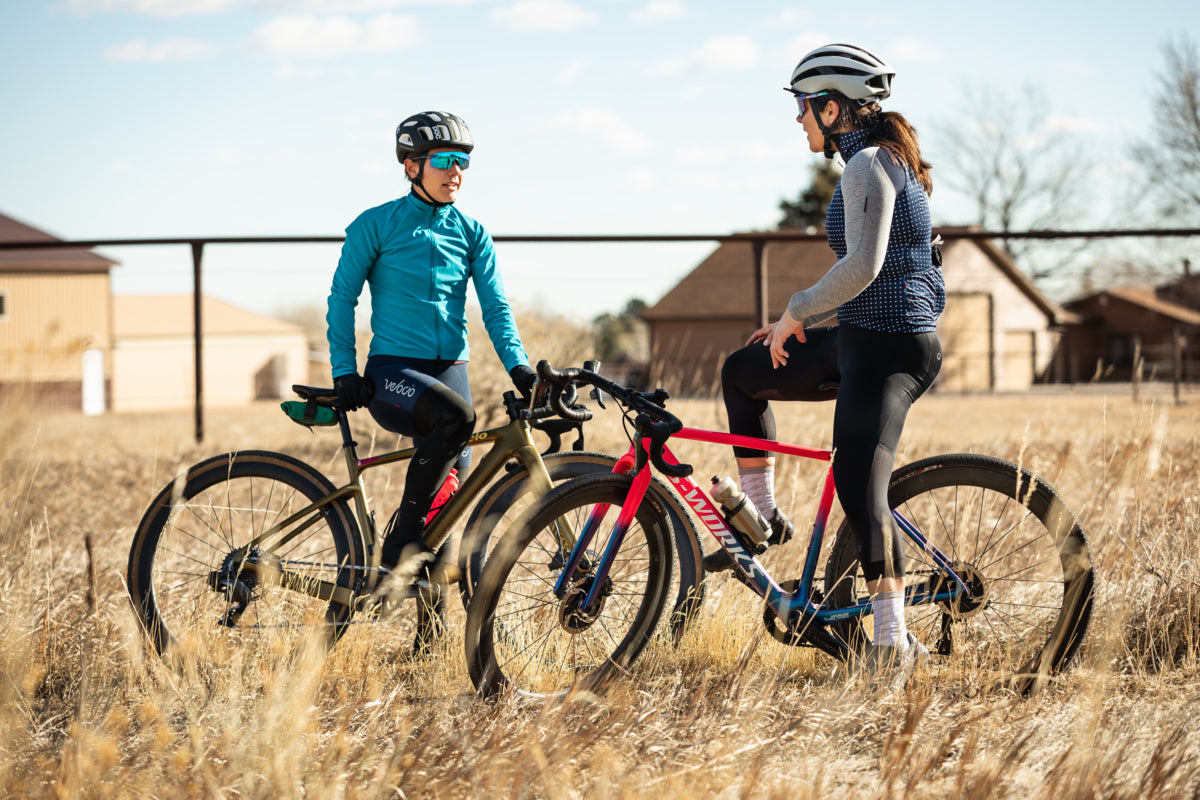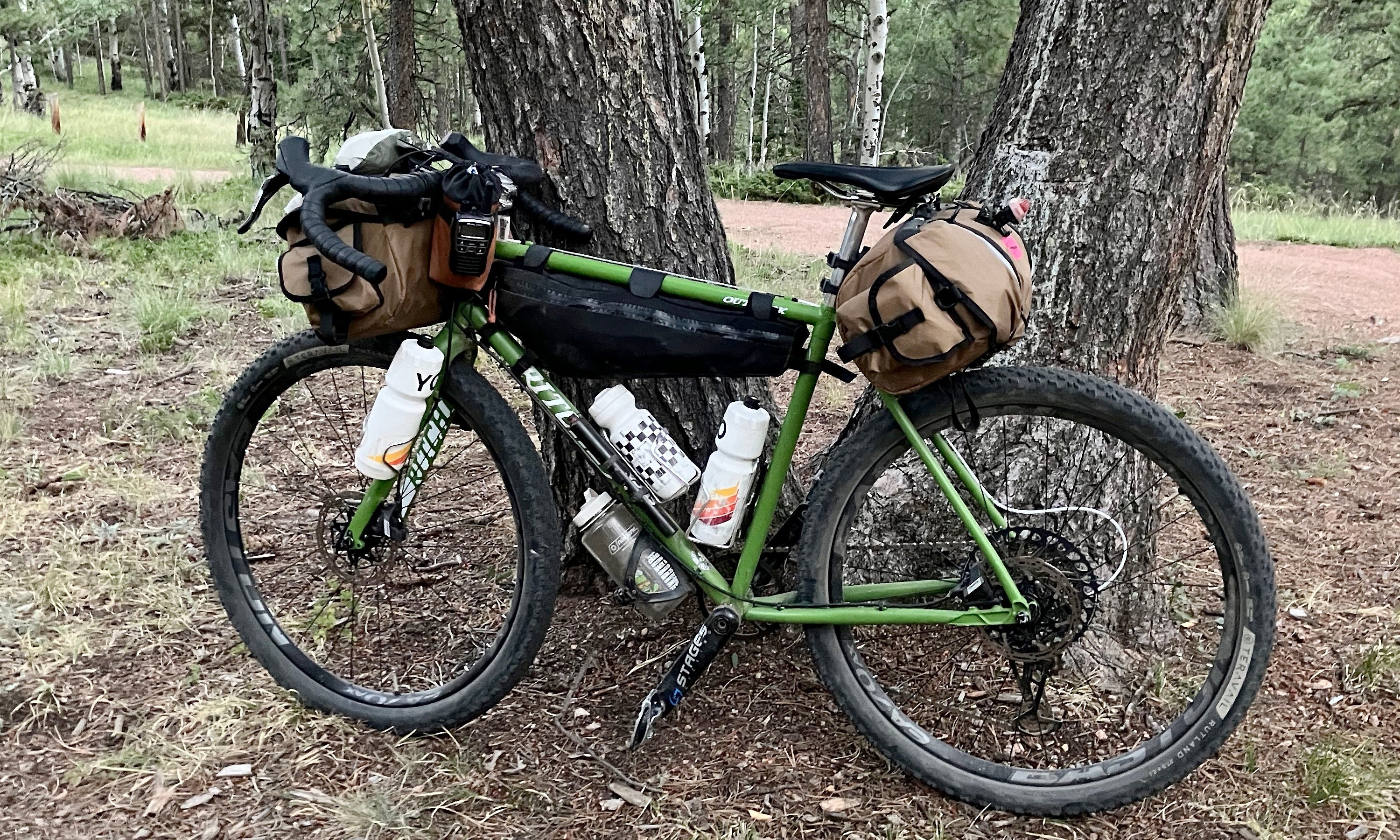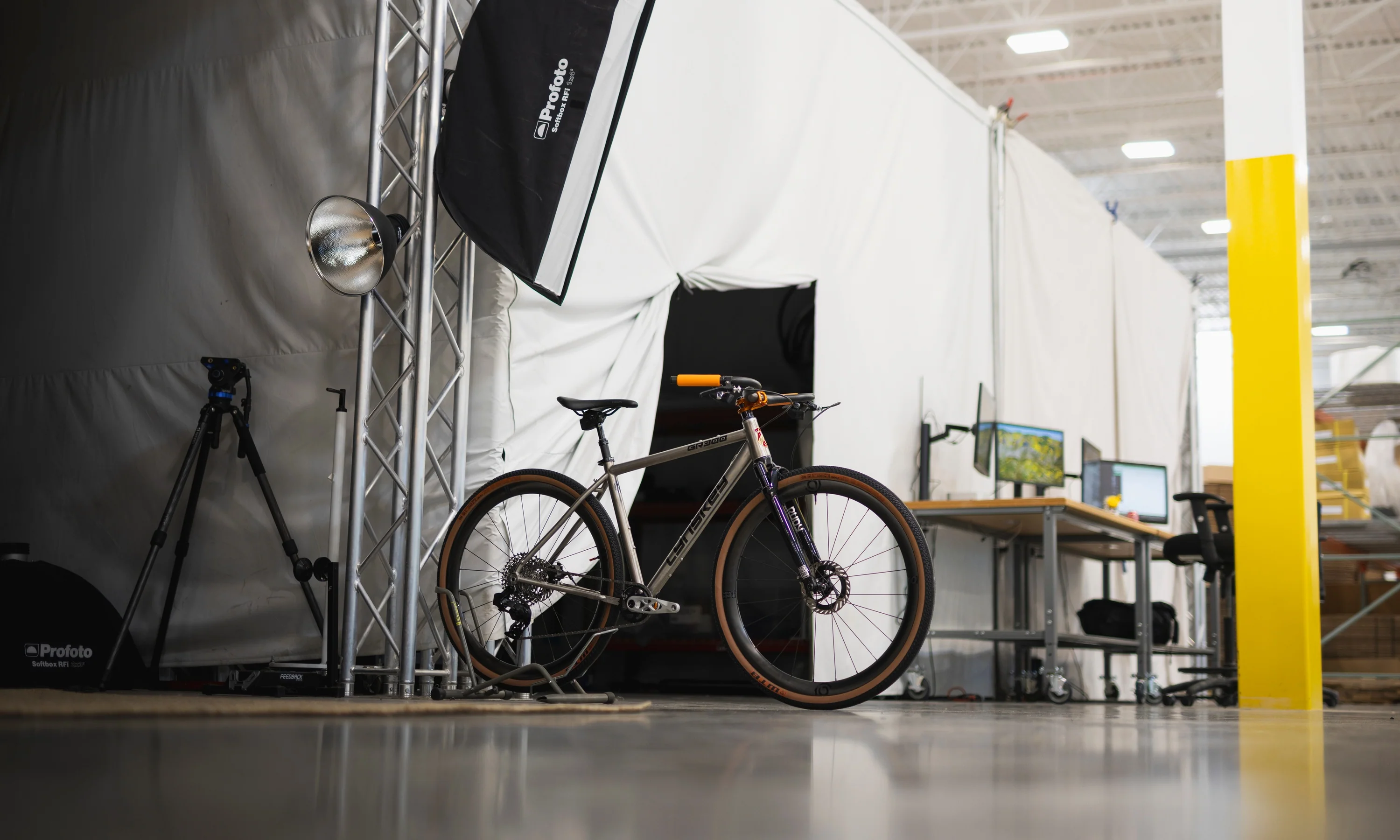Gravel might have started off as the indie version of road cycling, but in the last decade, it’s gone mainstream. That’s a good thing! Now, there are lots of great gravel bikes that make venturing off the paved path accessible and enjoyable for any rider. Even gravel-specific drivetrains have emerged to satisfy the needs of gravel riders.
There are currently three main gravel-specific drivetrain offerings on the market: Shimano GRX, SRAM XPLR eTap AXS, and Campagnolo Ekar. Let’s break down some of the key differences between these three groups so you can choose which gravel drivetrain is best for you.
[button]Shop gravel bikes[/button]
Gravel drivetrains vs. Road bike drivetrains
 What exactly makes drivetrains like Shimano GRX, SRAM XPLR eTap AXS, and Campagnolo Ekar better for gravel than road drivetrains? There are two key technologies: lower gearing and clutched rear derailleurs.
What exactly makes drivetrains like Shimano GRX, SRAM XPLR eTap AXS, and Campagnolo Ekar better for gravel than road drivetrains? There are two key technologies: lower gearing and clutched rear derailleurs.
Gravel bike gearing
Road bike gearing: 2x chainrings, narrower range cassette, higher top speeds.
Gravel bike gearing: 1x or 2x chainrings, wider range cassette, easier low gears.
Most road bikes use two chainrings (2x). This provides ample gear range with a big outer chainring to achieve high top speeds and a smaller inner chainring to handle steep climbs.
Gravel bikes can use either 1x or 2x drivetrains and often have wider-range cassettes than road bikes. Most gravel riding is done at lower speeds and on loose surfaces, so gravel gearing prioritizes lower (i.e., easier) gears. These “granny gears” are better for crawling up steep and loose dirt climbs or riding while loaded with extra bags and gear.
[newsletter]
Clutched rear derailleurs
Clutch technology comes from mountain bikes and it’s used on gravel rear derailleurs to improve chain retention. The clutch holds the derailleur cage back to maintain tension on the chain while pedaling or coasting. With a clutch, you’re less likely to drop your chain while riding rough terrain.
Shimano GRX vs. SRAM XPLR AXS vs. Campagnolo Ekar
|
Gravel group |
Type |
Speeds |
|
Shimano |
||
|
GRX RX400 |
Mechanical |
2x10 |
|
GRX RX600 |
Mechanical |
1x11, or 2x11 |
|
GRX RX800 |
Mechanical |
1x11 or 2x11 |
|
GRX RX800 Di2 |
Electronic |
1x11 or 2x11 |
|
SRAM |
||
|
Rival XPLR eTap AXS |
Electronic |
1x12 |
|
Force XLPR eTap AXS |
Electronic |
1x12 |
|
Red XPLR eTap AXS |
Electronic |
1x12 |
|
Campagnolo |
||
|
Ekar |
Mechanical |
1x13 |
In the last three years, each of the three major component manufacturers have released a new gravel-specific drivetrain. Shimano introduced GRX in 2019, Campagnolo introduced Ekar in 2020, and SRAM introduced XPLR eTap AXS in 2021.
 Shimano GRX is offered in three levels, RX400, RX600, and RX800, which roughly equate to its Tiagra, 105, and Ultegra road groups. GRX RX400 groups are 2x10 speed. GRX RX600 and RX800 groups are both 11-speed and can be set up as either a 1x or 2x. GRX RX800 groups come in a mechanical version or an electronic Di2 version. GRX has no Dura-Ace (Shimano’s top-of-the-line road group) equivalent.
Shimano GRX is offered in three levels, RX400, RX600, and RX800, which roughly equate to its Tiagra, 105, and Ultegra road groups. GRX RX400 groups are 2x10 speed. GRX RX600 and RX800 groups are both 11-speed and can be set up as either a 1x or 2x. GRX RX800 groups come in a mechanical version or an electronic Di2 version. GRX has no Dura-Ace (Shimano’s top-of-the-line road group) equivalent.
[product-block handle="2021-allied-able-l"/]
 SRAM XPLR eTap AXS is a wireless electronic group. The Rival, Force, and Red naming convention is the same as SRAM’s road groups. If you’re comparing them to Shimano drivetrains, Rival, Force, and Red align with 105/RX600, Ultegra/RX800, and Dura-Ace groups.
SRAM XPLR eTap AXS is a wireless electronic group. The Rival, Force, and Red naming convention is the same as SRAM’s road groups. If you’re comparing them to Shimano drivetrains, Rival, Force, and Red align with 105/RX600, Ultegra/RX800, and Dura-Ace groups.
[product-block handle="2022-canyon-grizl-cf-slx-8-etap-l"/]
 Campagnolo Ekar is the Italian brand’s only gravel drivetrain offering. In terms of build quality and price, it is closest to Campagnolo’s Record road group (which competes with Shimano Ultegra and SRAM Force).
Campagnolo Ekar is the Italian brand’s only gravel drivetrain offering. In terms of build quality and price, it is closest to Campagnolo’s Record road group (which competes with Shimano Ultegra and SRAM Force).
To compare these drivetrains we’re going to look at the three key features: gearing, weight, and cost.
[product-block handle="2020-3t-exploro-race-ekar-l"/]
Gearing
|
Gravel drivetrain |
Chainring options |
Cassette options |
|
GRX 2x |
46/30T, 48/31T |
11-30T, 11-32T, 11-34T, 11-40T |
|
GRX 1x |
40T - 42T |
11-40T, 11-42T |
|
XPLR eTap AXS |
36T - 50T |
10-44T |
|
Ekar |
38T - 44T |
9-36T, 9-42T, 10-44T |
Pay attention to the highest and lowest gears. SRAM XPLR offers the highest possible gear with a 50x10T gear combo. Ekar is close behind with a 44x9T combo. In terms of low gears, Shimano GRX’s 2x option with its 30x40T granny gear is the winner.
Shimano GRX 1x gearing has limited chainring options. XPLR and Ekar 1x drivetrains use 10T and 9T small cogs on their cassettes and have more options for smaller chainrings to achieve low gearing while maintaining a suitable high gear for fast riding. Most 1x riders will ride a 40, 42, or 44T chainring. For example, if you use a 42T chainring with SRAM XPLR, you still have a high gear very close to the 48x11T on Shimano GRX while maintaining a fairly easy 42x44T low gear for climbing.
For gravel, low gears are usually more important than high gears. Achieving high top speeds only matters for racers. For everyone else, a drivetrain with gearing that makes it easy to pedal up your local climbs is more important. Also, keep in mind that this table doesn’t take into account third-party chainring and cassette options. By mixing and matching different parts, you can feasibly get any gearing you want.
If you want to learn more about choosing 1x vs. 2x drivetrains for gravel, check out our 1x vs 2x story.
Weight
|
Component |
Weight |
|
Shifters (w/ brake calipers) |
|
|
Shimano GRX RX800 1x (mechanical / Di2) |
852g |
|
SRAM Force eTap Axs |
822g |
|
Campagnolo Ekar |
880g |
|
Cranksets |
|
|
Shimano GRX RX800 1x (172.5mm, 42T) |
656g |
|
SRAM Force 1 (172.5mm, 42T) |
720g |
|
Campagnolo Ekar (172.5mm, 44T) |
615g |
|
Rear Derailleur |
|
|
Shimano GRX RX800 (long cage - mechanical) |
267g |
|
SRAM Force XPLR eTap AXS |
308g (+20g battery) |
|
Campagnolo Ekar |
275g |
|
Cassette |
|
|
Shimano Deore XT M8000 (11-42T) |
437g |
|
SRAM XPLR XG-1271 (10-44T) |
378g |
|
Campagnolo Ekar (9-42T) |
390g |
|
Total weight (1x) |
|
|
Shimano GRX 1x |
2,212g |
|
SRAM Force XPLR eTap AXS |
2,248g |
|
Campagnolo Ekar |
2,160g |
Comparing weight between these three drivetrains is tricky, because it will vary significantly based on configuration. To get the closest comparison possible, this table compares four main components (shifters, crankset, rear derailleur, and cassette) from the three most comparable groups (RX800, Force, and Ekar) in similar 1x configurations.
As you can see, Campagnolo wins the weight game, but it’s all surprisingly close. Campagnolo Ekar is only 88 grams less than the SRAM Force XPLR eTap AXS. Will three ounces of drivetrain weight really matter? Well, that’s up to you, but I say it doesn’t matter.
Also keep in mind that, for fairness, I chose to compare SRAM’s Force drivetrain, instead of the top-of-the-line Red drivetrain. Red sheds more weight (the crankset is a feathery 555g) thanks to more carbon fiber and extensive machining, but it costs a lot more.
If you choose to go the 2x route for GRX the crankset will be heavier (710 grams) and you’ll have the added weight of a front derailleur (96g), but the cassette will be lighter (335g). If you want to compare GRX Di2 components, the rear derailleur (288g) and front derailleur (131g) are slightly heavier while the shifters are only 7 grams lighter.
Cost
|
Component |
Cost |
|
Shifters (w/ brake calipers) |
|
|
Shimano GRX RX800 1x (mechanical / Di2) |
$760 / $1,096 |
|
SRAM Force eTap Axs |
$700 |
|
Campagnolo Ekar |
$689 |
|
Cranksets |
|
|
Shimano GRX RX800 1x |
$235 |
|
SRAM Force 1 |
$254 |
|
Campagnolo Ekar |
$360 |
|
Rear Derailleur |
|
|
Shimano GRX RX800 (mechanical / Di2) |
$118 / $270 |
|
SRAM Force XPLR eTap AXS |
$269 |
|
Campagnolo Ekar |
$256 |
|
Cassette |
|
|
Shimano Deore XT M8000 (11-42T) |
$105 |
|
SRAM XPLR XG-1271 (10-44T) |
$222 |
|
Campagnolo Ekar (9-42T) |
$275 |
|
Total Cost (1x) |
|
|
Shimano GRX 1x (mechanical / Di2) |
$1,218 / $1,706 |
|
SRAM Force XPLR eTap AXS |
$1,445 |
|
Campagnolo Ekar |
$1,580 |
Again, to simplify, we’re only comparing the retail prices for four key components (shifters, crankset, rear derailleur, and cassette) from the three most comparable groups (RX800, Force, and Ekar). Obviously, this isn’t representative of the cost of buying complete groups (with chains, bottom brackets, and disc brake rotors), but most riders will purchase these drivetrains on complete bikes. This should give you an idea of how much value each drivetrain adds to a bike.
Based on these numbers, Campagnolo Ekar is the most expensive mechanical drivetrain while Shimano GRX Di2 is the most expensive electronic drivetrain. Shimano also has the most affordable mechanical option with GRX mechanical.
Of course, the top-of-the-line SRAM Red XPLR is more expensive than all of the above, and SRAM Rival XPLR, GRX RX600, and RX400 are all cheaper. If you want to get the most bang for your buck, I recommend Rival XPLR. If you’re on a very tight budget, GRX RX600 and RX400 are good options.
Final thoughts
 So what have we learned? Weight is surprisingly similar between the three drivetrain options, if you’re comparing similar configurations. That means the main considerations should be gearing, cost, and then subjective factors like brand loyalty, ergonomics, or aesthetics. There’s also the matter of deciding between mechanical and electronic drivetrains. (Check out our electronic drivetrain article to learn more about the advantages of going electronic.)
So what have we learned? Weight is surprisingly similar between the three drivetrain options, if you’re comparing similar configurations. That means the main considerations should be gearing, cost, and then subjective factors like brand loyalty, ergonomics, or aesthetics. There’s also the matter of deciding between mechanical and electronic drivetrains. (Check out our electronic drivetrain article to learn more about the advantages of going electronic.)
You want to ride a 2x — Shimano GRX is the best (and only) option.
You want electronic shifting — With wireless shifting, 12-speeds, widespread adoption, and plenty of race success, SRAM XPLR eTap AXS is the current gold standard for electronic gravel drivetrains.
You’re on a tight budget — Shimano GRX RX600 and RX400 are the most affordable drivetrains and will be found on many entry- to mid-level gravel bikes. SRAM Rival XPLR eTap AXS is the best option for those who want an affordable electronic drivetrain.
You want to stand out from the crowd — Campagnolo Ekar has 13 speeds and is definitely the rarest drivetrain option of the three. Plus, it gets bonus points for being Italian.
You need easier gearing for climbs — Pick your poison. The 2x GRX group has the lowest possible gear, but any of these groups can be set up with a smaller chainring to conquer the steepest climbs. The benefit of 2x GRX is that you still have plenty of high gears if you want them. There’s also SRAM’s “Mullet” drivetrain option which swaps the rear derailleur and cassette for SRAM Eagle MTB components. You get a massive 10-50T or 10-52T cassette, and because AXS components are wireless, they’re easy to mix and match.
What gravel drivetrain would you choose? Let me know which you would pick and why in the comments!
[button]Shop gravel bikes[/button]

























